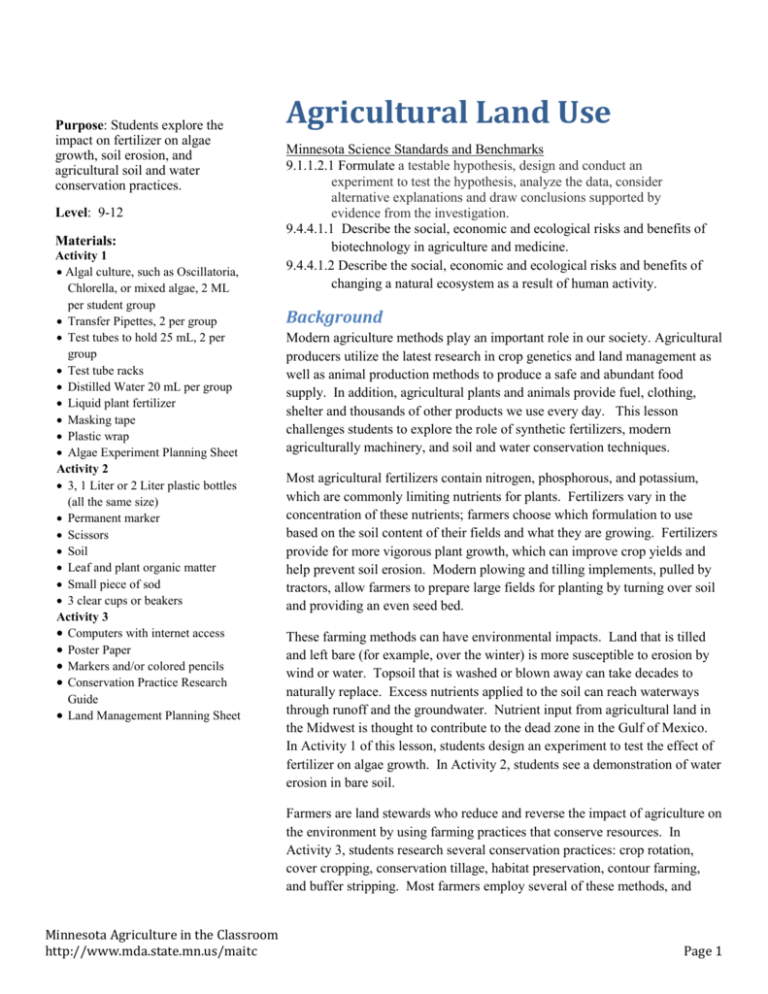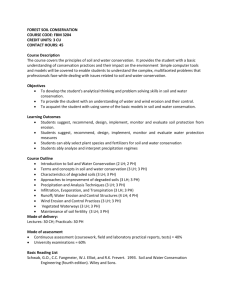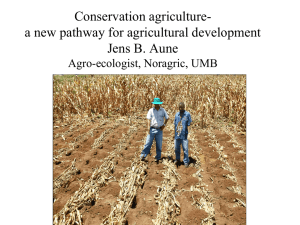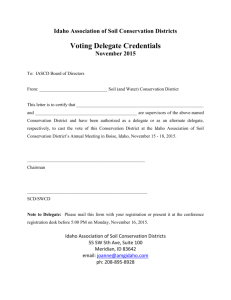Land Use 9
advertisement

Purpose: Students explore the impact on fertilizer on algae growth, soil erosion, and agricultural soil and water conservation practices. Level: 9-12 Materials: Activity 1 Algal culture, such as Oscillatoria, Chlorella, or mixed algae, 2 ML per student group Transfer Pipettes, 2 per group Test tubes to hold 25 mL, 2 per group Test tube racks Distilled Water 20 mL per group Liquid plant fertilizer Masking tape Plastic wrap Algae Experiment Planning Sheet Activity 2 3, 1 Liter or 2 Liter plastic bottles (all the same size) Permanent marker Scissors Soil Leaf and plant organic matter Small piece of sod 3 clear cups or beakers Activity 3 Computers with internet access Poster Paper Markers and/or colored pencils Conservation Practice Research Guide Land Management Planning Sheet Agricultural Land Use Minnesota Science Standards and Benchmarks 9.1.1.2.1 Formulate a testable hypothesis, design and conduct an experiment to test the hypothesis, analyze the data, consider alternative explanations and draw conclusions supported by evidence from the investigation. 9.4.4.1.1 Describe the social, economic and ecological risks and benefits of biotechnology in agriculture and medicine. 9.4.4.1.2 Describe the social, economic and ecological risks and benefits of changing a natural ecosystem as a result of human activity. Background Modern agriculture methods play an important role in our society. Agricultural producers utilize the latest research in crop genetics and land management as well as animal production methods to produce a safe and abundant food supply. In addition, agricultural plants and animals provide fuel, clothing, shelter and thousands of other products we use every day. This lesson challenges students to explore the role of synthetic fertilizers, modern agriculturally machinery, and soil and water conservation techniques. Most agricultural fertilizers contain nitrogen, phosphorous, and potassium, which are commonly limiting nutrients for plants. Fertilizers vary in the concentration of these nutrients; farmers choose which formulation to use based on the soil content of their fields and what they are growing. Fertilizers provide for more vigorous plant growth, which can improve crop yields and help prevent soil erosion. Modern plowing and tilling implements, pulled by tractors, allow farmers to prepare large fields for planting by turning over soil and providing an even seed bed. These farming methods can have environmental impacts. Land that is tilled and left bare (for example, over the winter) is more susceptible to erosion by wind or water. Topsoil that is washed or blown away can take decades to naturally replace. Excess nutrients applied to the soil can reach waterways through runoff and the groundwater. Nutrient input from agricultural land in the Midwest is thought to contribute to the dead zone in the Gulf of Mexico. In Activity 1 of this lesson, students design an experiment to test the effect of fertilizer on algae growth. In Activity 2, students see a demonstration of water erosion in bare soil. Farmers are land stewards who reduce and reverse the impact of agriculture on the environment by using farming practices that conserve resources. In Activity 3, students research several conservation practices: crop rotation, cover cropping, conservation tillage, habitat preservation, contour farming, and buffer stripping. Most farmers employ several of these methods, and Minnesota Agriculture in the Classroom http://www.mda.state.mn.us/maitc Page 1 many farmers are innovating and doing on-farm research to make the best sustainable choices for their land. Vocabulary algal bloom: A rapid increase in the population of algae in a given area of water, which often causes the water to look green. fertilizer: Material added to soil to increase soil fertility and crop yield. Fertilizers can be organic (such as manure or compost) or inorganic. hypoxic: Water that is low in dissolved oxygen. plowing: The act of turning over the top layer of soil to prepare for planting. Plowing brings nutrients to the soil surface and buries old plant litter. In modern U.S. agriculture, plows are usually large pieces of machinery mounted to tractors. tilling: Preparing soil for planting by breaking up clumps of soil to provide an even bed for seeds. Tilling implements are also usually mounted to tractors. topsoil: The top layer of soil, where most nutrients are available for plants. erosion: The process of removing topsoil from one area and depositing it in another through the action of wind or water. conservation practices: Farming methods that conserve farmland and maintain resources by reducing erosion and surface runoff, protecting soil nutrients, and/or providing wildlife habitat. crop rotation: The practice of growing different types of crops on the same plot of land in sequential growing seasons. Different crops use different amounts of nutrients. If the same crop is planted continuously, the soil will become depleted of some nutrients more than others, increasing fertilizer use. For example, some crops use a lot of nitrogen, while others are able to return nitrogen to the soil. A common rotation used in Minnesota is to plant corn one year and soybeans the next year, since soybeans are legumes, which return nitrogen to the soil. cover cropping: Cover cropping helps reduce erosion. Instead of leaving bare soil when the main crop is harvested, farmers plant an additional crop and leave it in the field over the winter. For example, a farmer might harvest corn and then plant rye to cover the field. conservation tillage: Soil preparation that leaves crop residue from the previous year’s crop on the field. For example, corn stalks may be left on the field after harvest and soybeans planted directly into the corn residue the next spring. Keeping the soil covered in this manner reduces erosion and runoff. habitat preservation: An area of a farm that is reserved in or returned to its pre-cultivation state, such as a grassland or wetland. These areas provide food Minnesota Agriculture in the Classroom http://www.mda.state.mn.us/maitc Page 2 and shelter for wildlife and prevent erosion and runoff, and provide an alternative to farming marginal land. contour farming: In hilly areas, rows of crops are planted perpendicular to the slope rather than parallel to the slope, following the contour of the land. This slows runoff from the land, allowing water to infiltrate the soil and reducing erosion. filter strip: An area of vegetation, often grass, planted at the edge of a field next to a body of water such as a lake or river. Filter strips help protect water quality by trapping and filtering sediment, nutrients, and other pollutants in runoff. Procedure Activity 1 - How does fertilizer affect algae growth? 4 days before you plan to teach the lesson, have students set up algal cultures. They will plan and conduct a simple experiment to test the effect of fertilizer on algae growth using the Algae Experimental Planning Sheet. 1. Ask students if they have heard of fertilizer and why it is used. They may be familiar with lawn or agricultural fertilizer and may answer that it helps plants grow. 2. Pass out the Algae Experimental Planning Sheet. Have each lab group predict what the effect of fertilizer will be, and sketch out a basic experimental procedure (students should not worry about amounts of algae at this point). After students have planned their experiments, review the following procedure to make sure all students have set up an appropriate experiment. a. Obtain two test tubes. Label one “Control” and one “Fertilizer.” b. Use a clean transfer pipette to add 20 drops of algal culture to each test tube. c. Add 4 drops of fertilizer to the “Fertilizer” tube. d. Cover the tubes with plastic wrap. Poke holes in the plastic to allow for air exchange. e. Place the beakers in a sunny window or under fluorescent light for 4 days. Have students record their observations each day. 3. Discuss the results of the algae experiment as a class. Students should notice that the test tubes containing fertilizer were greener than the control tubes, indicating faster algae growth with fertilizer. Ask students to share why they think this is. Students should come away with an understanding that the fertilizer contains nutrients (N, P, K) that enable the algae to grow faster. Minnesota Agriculture in the Classroom http://www.mda.state.mn.us/maitc Page 3 Activity 2 - What are the environmental impacts of agriculture? Before you begin this activity, set up the erosion demonstration – see Step 3. below 1. Ask students to brainstorm ways that agriculture impacts the environment. Possible ideas include: natural resources (soil, water, air quality) animal habitat biodiversity conserve land energy/fossil fuel use waste 2. Show the image of the tractors plowing and tilling (Slide # 1 in Land Management Presentation). Explain that plowing turns over the first layer of soil (about 12 inches) and that tilling further breaks up the soil to make an even surface for planting. 3. Ask students what effect they believe plowing and tilling has on erosion, the removal of soil by wind or water. Demonstrate erosion in three different conditions: bare soil, soil with some cover, and soil with plants in it. a. Collect three plastic bottles of equal size (1-L or 2-L). Lay the bottles flat and cut an oval shape around the top to create a “boat.” Make sure that the sides of your boat are higher than the mouth of the bottle. b. Fill two of the bottles with soil. Cover the soil in one of these bottles with leaf and plant matter. Place the sod in the third bottle. c. Set up the three bottles so students can see them. Elevate the far ends of the bottles so that water will drain out of them. Place a clear cup or beaker beneath the mouth of each bottle. Minnesota Agriculture in the Classroom http://www.mda.state.mn.us/maitc Page 4 4. 5. 6. 7. d. Ask students to predict which soil sample will have the most erosion, or the most sediment in the runoff. e. Pour an equal amount of water (~100 mL) onto the soil or plant matter in each bottle “boat” and evaluate the results by looking at the color of the runoff. Show the image of soil layers (Slide #2 in Land Management Presentation). The top layer is called topsoil, and it is where the nutrients and water that plants need to grow are stored. Topsoil is formed over hundreds of years by the breaking down of rock or soil parent material, and therefore cannot easily be replaced when it is eroded. Ask students, “What is fertilizer and why is it used?” Explain that farmers use fertilizers to increase the nitrogen, phosphorous, and potassium available to their plants. (Slide #3 in Land Management Presentation). Refer back to the results of the algae experiment in Activity 1. Ask students how fertilizer use by farmers and homeowners could cause more algae to grow in lakes and rivers. Show the image of the largest sources of nitrogen to streams (Slide #4 in Land Management Presentation). Ask students to identify the Mississippi river and tributaries. Point out the cropland and manure as sources of nitrogen and that the Midwest contributes the most, as shown in dark blue (Slide #5 in Land Management Presentation). Show the image of the algae bloom (Slide #5 in Land Management Presentation). Ask students how the excess algae affect the aquatic ecosystem. Students may believe that the excess algae provide more food for other marine organisms. However, when the algae die, they are decomposed at the bottom of the ocean or lake. Decomposers use up the dissolved oxygen, resulting in a hypoxic zone. The salt and temperature gradient prevents surface oxygenated water from mixing with the hypoxic water. While older fish can usually swim to safer waters, young fish, shellfish, mussels, and crabs may be killed due to lack of oxygen. Activity 3 - How do farmers reduce the environmental impacts of agriculture? 1. Divide students into groups and assign each group one of the following conservation practices: a. Crop rotation b. Filter strip c. Cover cropping d. Contour farming e. Conservation tillage f. Habitat preservation g. Any other conservation techniques that interest students Minnesota Agriculture in the Classroom http://www.mda.state.mn.us/maitc Page 5 2. Have student groups research their conservation practice to answer the questions on the Conservation Practice Research Guide. The following websites are good resources: Minnesota Department of Agriculture Conservation Practices https://www.mda.state.mn.us/protecting/conservation/practices.aspx https://www.mda.state.mn.us/protecting/conservation/covercrops.aspx USDA Natural Resources Conservation Service Conservation Practices http://www.nrcs.usda.gov/wps/portal/nrcs/detailfull/null/?cid=nrcs143 _026849 3. Students will develop a poster to illustrate the practice and how it benefits the environment and share this information with the class. As each group presents their poster, the rest of the class should take notes on the major environmental benefits and uses of each conservation practice for use in Activity 4. Activity 4 – What is your land management plan? Students will apply the information they learned from the class presentations to a new situation. Students will imagine that they have inherited a parcel of farmland in Minnesota. Ask students what kind of information they would like to know about their new land. The Land Management Plan sheet gives information about the new farmland, including a map of the land and existing structures. Based on this information, students will each suggest at least two conservation practices they would choose to employ on their new farm. Students must justify their choices by writing a paragraph, stating how they expect each practice to benefit the farm and the environment, and indicate on the map the area where they would use each practice. Adaptations and Extensions: In the algae bloom experiment, students could test different amounts or types of fertilizer, or use pond water from a local source in place of algal culture. Have students research different types of fertilizer and their uses or different tilling implements and their uses. Resources Science Museum of Minnesota Dead Zone site: http://www.smm.org/deadzone/ Diaz, R. J., & Rosenberg, R. (2008). Spreading Dead Zones and Consequences for Marine Ecosystems. Science, 321(5891), 926-929 EPA Hypoxia 101: http://water.epa.gov/type/watersheds/named/msbasin/hypoxia101.cfm Credits Minnesota Agriculture in the Classroom http://www.mda.state.mn.us/maitc Algal bloom procedure adapted from Minneapolis Public Schools Erosion demonstration procedure adapted from http://www.lapappadolce.net/science-experiment-on-soilerosion/?lang=en Page 6 Name_________________________ Algae Experimental Planning Sheet Research Question: What is the effect of fertilizer on algae growth? Materials: Algal culture Distilled Water Liquid Plant Fertilizer Masking tape and markers Transfer pipettes test tubes test tube rack Plastic wrap Predict: Do you think fertilizer will affect algae growth? If so, how? Experimental Design: What is the independent variable in this experiment? What is the dependent variable? What factors will be controlled? How will you know if there fertilizer has an effect on algae growth? Minnesota Agriculture in the Classroom http://www.mda.state.mn.us/maitc Page 7 In the boxes below, draw a diagram to show how you will set up the experiment: Experimental Condition Control Procedure: After your class has agreed on a procedure, write the steps below: Minnesota Agriculture in the Classroom http://www.mda.state.mn.us/maitc Page 8 Observations: Day Observations 1 2 3 4 Results: In 3 sentences, summarize the results of your experiment below. How did it compare to other lab groups? What do you conclude about the effect of fertilizer on algae? Explain: Why do you believe you saw the results that you did? Hint: Keep in mind what the fertilizer contains. Extend: What is another research question you could test using the same materials? Minnesota Agriculture in the Classroom http://www.mda.state.mn.us/maitc Page 9 Name___________________________ Conservation Practice Research Guide Your group will become the class experts on your conservation practice and create a poster to explain the practice. Your poster must include the following information and a labeled drawing or diagram to illustrate the practice. 1. What is your group’s conservation practice? 2. Describe this practice 3. When or why is it used? Are there particular situations it is good for (for example, on a hill or near a road or a body of water)? 4. What is the major environmental benefit of this practice? 5. What are some additional benefits of this practice? 6. Any new vocabulary associated with the practice: Minnesota Agriculture in the Classroom http://www.mda.state.mn.us/maitc Page 10 Conservation Practice Research Guide - Windbreaks Example 1. What is your group’s conservation practice? Windbreaks 2. Describe the practice. Windbreaks are rows of trees or other tall plants that farmers plant in order to slow the wind speed over their fields. 3. When or why is it used? Are there particular situations it is good for (for example, on a hill or near a road or a body of water)? Windbreaks are used in particularly windy areas. They are planted perpendicular to the direction of the strongest winds. They are useful in flat areas that don’t have other things, such as buildings or trees, to stop the wind. 4. What is the major environmental benefit of this practice? Windbreaks help slow the erosion of soil by wind. The wind hits the plants and is slowed down, so that it cannot pick up as many soil particles. This means that more topsoil remains on the field. 5. What are some additional benefits of this practice? Can provide wildlife habitat (for example, birds can live in the trees). Can provide more water for crops by decreasing evaporation due to wind. Can protect crops from wind damage. 6. Any new vocabulary associated with the practice: Downwind: in the direction that the wind is blowing Sources: https://www.mda.state.mn.us/protecting/conservation/practices/fieldwindbreak.aspx http://www.nrcs.usda.gov/Internet/FSE_DOCUMENTS/nrcs143_026743.pdf http://www.nrcs.usda.gov/Internet/FSE_DOCUMENTS/stelprdb1046943.pdf Minnesota Agriculture in the Classroom http://www.mda.state.mn.us/maitc Page 11 Name____________________________ Land Management Plan Congratulations! You have just inherited 320 acres (about 0.5 square miles) of farmland in southern MN. You have not been to visit your new farm, but you know some basic information about it and have a map. There is a farmhouse on the property, and it is bordered to the west by a stream. There is a low area on the property that is often flooded. Your relative had been growing corn and soybeans on the land. In the space below, write a proposal for at least two conservation practices you wish to use on your land. 1. Choose which conservation practices you will use. 2. Indicate on the map where you will use those practices. 3. Write a paragraph to justify why you have chosen the practices and their locations. Make sure to discuss the benefits to your farm and the environment. road flooded area house stream CORN SOYBEANS Minnesota Agriculture in the Classroom http://www.mda.state.mn.us/maitc CORN Page 12 Minnesota Agriculture in the Classroom http://www.mda.state.mn.us/maitc Page 13








